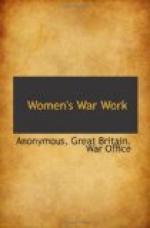“Blighty” is Home, the British soldiers in India’s corruption of the Hindustanee, and Blighty is a word we all know well now.
The full records of this are not easy to give—so much has been done. Perhaps the simplest way is to begin with the soldier at the training camp and follow him through his soldier’s existence. The first work lies in giving him comforts, and the women of our country still knit a good deal and in the early days knitted, as you do now to get your supplies, in trains and tubes and theatres and concerts, and public meetings. This was happening while many of our working women were without work and it was felt that this was likely to compete very seriously with the work of these women. The Queen realized there was likely to be hardships through this and also that there would probably be a great waste of material if voluntary effort was not wisely guided. So she called at Buckingham Palace a committee of women to consider the position and Queen Mary’s Needlework Guild was the outcome of it. The following official statement, issued on August 21, 1914, intimated the Queen’s wishes and policy.
Queen Mary’s Needlework Guild has received representations to the effect that the provision of garments by voluntary labor may have the consequence of depriving of their employment workpeople who would have been engaged for wages in the making of the same garments for contractors to the Government. A very large part of the garments collected by the Guild consists, however, of articles which would not in the ordinary course have been purchased by the Government. They include additional comforts for the soldiers and sailors actually serving, and for the sick and wounded in hospital, clothing for members of their families who may fall into distress, and clothing to be distributed by the local committees for the prevention and relieving of distress among families who may be suffering from unemployment owing to the war. If these garments were not made by the voluntary labor of women who are willing to do their share of work for the country in the best way open to them, they would not, in the majority of cases, be made at all. The result would be that families in distress would receive in the winter no help in the form of clothing, and the soldiers and the sailors and the men in hospitals would not enjoy the additional comforts that would be provided. The Guild is informed that flannel shirts, socks, and cardigan jackets are a Government issue for soldiers; flannel vest, socks, and jerseys for sailors; pajama suits, serge gowns for military hospitals; underclothing, flannel gowns and flannel waistcoats for naval hospitals. Her Majesty the Queen is most anxious that work done for the Needlework Guild should not have a harmful effect on the employment of men, women, and girls in the trades concerned, and therefore desires that the workers of the Guild should devote themselves to the making of garments other than those which would, in the




